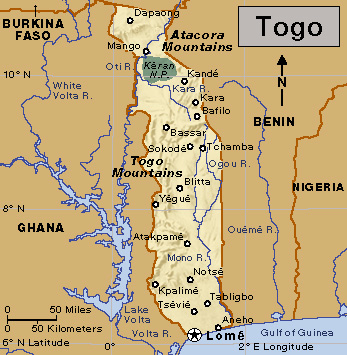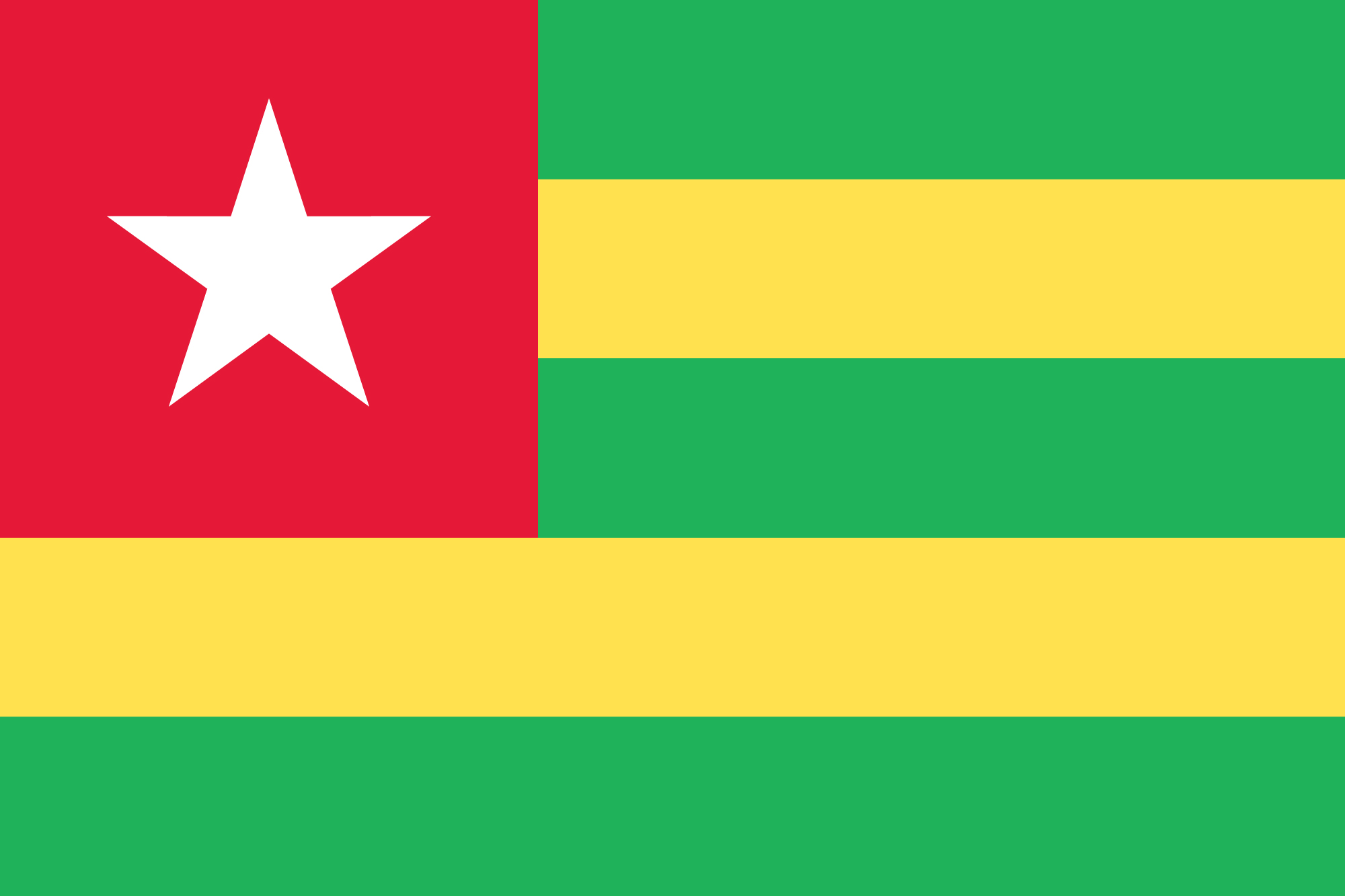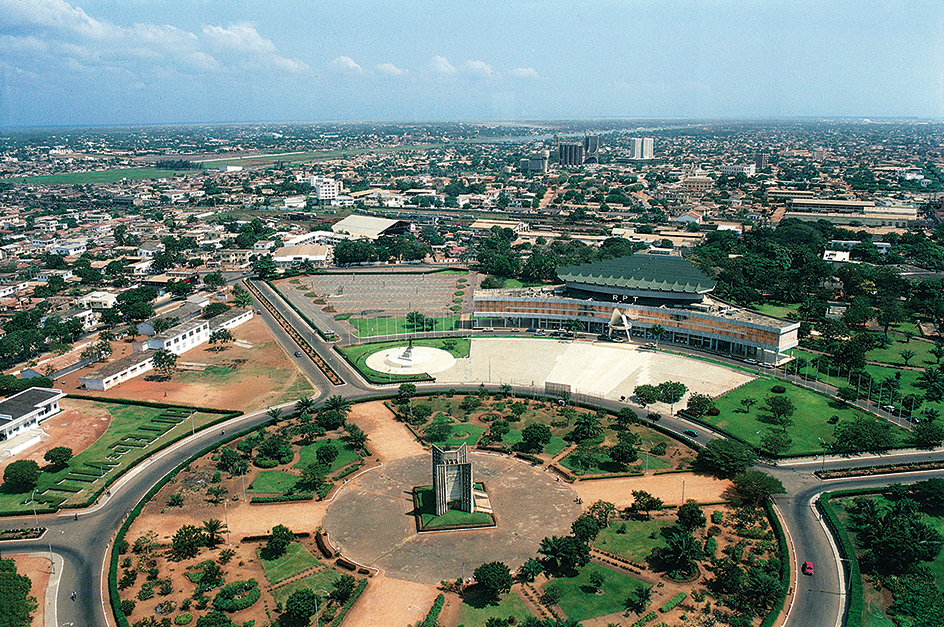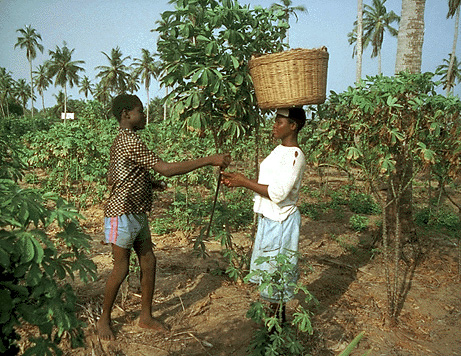Togo is a small, narrow country in western Africa. It extends about 343 miles (552 kilometers) inland from the Gulf of Guinea, an arm of the South Atlantic Ocean. Togo is only 31 miles (50 kilometers) wide at the coast and 87 miles (140 kilometers) wide at its widest point. Lomé is the country’s capital and only large city. Togo’s name in French, the official language, is République Togolaise (Togolese Republic).

Government.
The president is Togo’s most powerful official. Under the Constitution, the president is elected to a five-year term. The president appoints a prime minister. The lawmaking body, the National Assembly, has 91 members, elected by the people to five-year terms.
People.
About three-fifths of the Togolese live in rural areas and work on farms. The Ewe << AY vay >> and related peoples make up about 40 percent of the population. The Kabyè << kah bee YAY >> make up about 13 percent. Togo also has about 35 other ethnic groups. About half of the population are Christians, about one-third practice traditional African religions, and about one-sixth are Muslims.

Customs differ throughout Togo, especially between the south and the north. The ancestors of the people in southern Togo came from what are now Benin and Ghana. Many southerners live in groups of dwellings that are sometimes surrounded by a hedge or a fence of braided palms. Most southerners speak the Ewe or Mina languages. European influence has been greater in the south than in the north. Some southerners work for the government, and others work in business, education, or trade. Most of Togo’s Christian population, which is largely Roman Catholic, lives in the south. 
Northern Togo was settled by a variety of peoples from what are now Burkina Faso and other countries. Some northerners live in castlelike groups of mud-brick houses with cone-shaped thatched roofs. Many languages, including Kabyè, Kotokoli, and Mina, are spoken in the north. Most of Togo’s Muslims live there.
About 70 percent of Togo’s children attend primary school. About 20 percent go to secondary school. Togo has a university at Lomé. Many Togolese study abroad, especially in France, Germany, and the United States.
Land.
The Togo Mountains stretch from southwest to northeast and cover much of western Togo. Mont Agou (3,235 feet, or 986 meters) is Togo’s highest point.
East and south of the Togo Mountains, the land descends across a sloping plateau to a low, sandy coastal plain. Tall grass and clumps of hardwood trees cover the plateau, which is drained by the Mono River. The densely populated coastal plain is dotted with swamps, lagoons, and coconut and oil palm forests.
North of the Togo Mountains, the land descends through rolling grasslands to the border of Burkina Faso. The Oti River drains the region. Few people live there. Thorny trees are scattered across the grasslands.
Togo has a hot climate. Average temperatures at Lomé, on the coast, range from 73 °F (23 °C) to 86 °F (30 °C). At Sansanné-Mango, in the north, average temperatures range from 59 °F (15 °C) to 95 °F (35 °C). Yearly rainfall averages about 40 inches (100 centimeters) in the north, about 70 inches (180 centimeters) in the southwest at Kpalimé, and about 35 inches (89 centimeters) at Lomé.
Economy.
Togo is one of the world’s poorest nations. The country’s economy is largely based on agriculture. Many of Togo’s workers are farmers. The country can grow sufficient food in years of adequate rainfall. But good land is limited, access to water and fertilizers is often difficult, and income is low.
Most farms in Togo are owned by families producing only enough food to feed themselves. Family farms throughout Togo raise a variety of food crops. These crops include cassava, corn, millet, rice, sorghum, and yams. Farmers also raise cattle, chickens, and pigs. Export crops include cocoa, coffee, and cotton.

Togo’s leading mined products include limestone and phosphates. Oil and gas, discovered off Togo’s coast, may someday benefit the nation’s economy. Manufacturing plays a small role in the country’s economy. Factories process agricultural products and manufacture cement and textiles.
Togo imports more than it exports. The country imports food, machinery, petroleum products, and transportation equipment. Cement, cocoa, coffee, cotton, and phosphates are among the leading exports. Togo’s main trading partners include Burkina Faso, China, France, Ghana, India, the Netherlands, and Nigeria.
History.
Little is known about the early history of what is now Togo. Scholars believe the ancestors of the central mountain peoples were early inhabitants of the region. Near present-day Notsé, archaeologists have found remains of walled cities that may date from about A.D. 1050. Between the 1100’s and the 1300’s, Ewe-speaking peoples began to move south from the Niger River valley to enter what are now southern Togo and Benin.
European explorers and traders began to visit the Togolese coast in the 1400’s. The Portuguese were the first to arrive. Later, Danish, Dutch, British, and French ships all sailed the area. From the 1500’s to the 1800’s, millions of Africans along the Gulf of Guinea coast were captured and shipped to the Western Hemisphere to work as slaves. The region that is now Togo was sandwiched between two powerful slave-trading kingdoms—the Ashanti kingdom to the west, and the Dahomey kingdom to the east. Many people fled to Togo to avoid the slave trading and wars of these two kingdoms. A small transatlantic slave trade was centered at Aného, on Togo’s coast. But most slave trading in the region was conducted at ports in what are now Benin and Ghana.
In the mid-1700’s, the Tchokossi people established an Islamic kingdom in northern Togo. In the 1800’s, the kola nut trade became the main economic activity in northern Togo. At the same time, trade in oil palm products replaced the slave trade at Aného.
German Protestant missionaries went to southern Togo in the mid-1800’s. In 1884, Germany set up a small protectorate on the coast. The Germans used force and treaties to gradually extend the borders of the protectorate northward. Some local peoples resisted the expansion. By 1899, German Togoland included what is now Togo and part of what is now Ghana.
British- and French-directed African troops captured German Togoland in 1914, during World War I (1914-1918). In 1919, the United Kingdom and France divided German Togoland. The western one-third went to the British, and the rest went to the French. In 1922, the League of Nations confirmed mandates (authority to govern) for the British and French over Togoland. The United Nations (UN) took over the mandate system and named the Togoland areas trusteeships in 1946. When the Gold Coast became independent as Ghana in 1957, it incorporated British Togoland. On April 27, 1960, French Togoland became the independent Republic of Togo.
In Togo’s first years of independence, Ewe peoples from the south dominated the government. But the Kabyè and other northern groups dominated the army. Sylvanus Olympio, a southerner who had been prime minister of French Togoland, was the first president of Togo. In 1963, a group of northern army officers assassinated Olympio. The officers installed one of Olympio’s political opponents, Nicolas Grunitzky, as president. But the government under Grunitzky remained unstable.
In 1967, army officers led by Etienne Eyadéma, a Kabyè, overthrew Grunitzky in a bloodless coup. Eyadéma took over as president. In 1969, the Rally of the Togolese People, headed by Eyadéma, became Togo’s only legal political party. Eyadéma was confirmed as president in a 1972 referendum. He also won presidential elections, unopposed, in 1979 and 1986. He took the African name Gnassingbé in 1974, and became known as Gnassingbé Eyadéma. Under Eyadéma, large numbers of Kabyè and other northerners were given government jobs. In addition, the military was controlled by Eyadéma supporters who used force to help him maintain power.
In the early 1990’s, Eyadéma’s opponents held protests to demand democratic reforms. Some violence broke out between protesters and Togolese security forces. In 1991, the government legalized political parties, and in 1992, Togo adopted a democratic constitution. But Eyadéma maintained his grip on power. He won presidential elections in 1993, 1998, and 2003, but many people believe the elections were rigged. His government often was accused of using intimidation and violence against political opponents.
In February 2005, Gnassingbé Eyadéma died. The Togolese military immediately installed his son Faure Gnassingbé as president. However, under the country’s Constitution, the speaker of the National Assembly was supposed to have assumed power until elections could be held. Leaders of many countries and international organizations criticized Gnassingbé’s appointment, calling it a military coup. Faced with protests in Togo and growing international pressure, Gnassingbé stepped down after only three weeks in power. But in April 2005, a presidential election was held, and Gnassingbé won the election.
In October 2007, a parliamentary election was held. It was the first time since the 1990’s that candidates from all political parties ran in the election. The ruling party won the majority of Assembly seats. Gnassingbé was reelected in 2010. The ruling party again won most of the Assembly seats in a 2013 parliamentary election. Gnassingbé was again reelected in 2015. In 2020, he was elected to a fourth term. The opposition claimed the vote count was marred by fraud, but the constitutional court rejected the claim and named Gnassingbé the winner.
In 2022, Togo joined the Commonwealth of Nations, an international association mostly made up of countries and territories that were once under British rule. Commonwealth members cooperate on many economic and foreign policy issues. Togo is one of several African countries that have joined the Commonwealth despite having no historic ties to the United Kingdom.
Also in 2022, Togo suffered attacks by Islamist militants affiliated with al-Qa`ida. Islamist terrorism had become widespread in western Africa in the 2010’s and 2020’s, but had not previously affected Togo. As a result of these attacks, President Gnassingbé took personal control of the Togolese armed forces.
See also Lomé.
